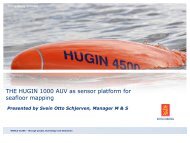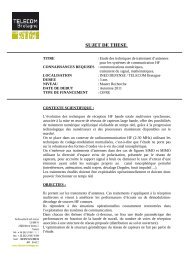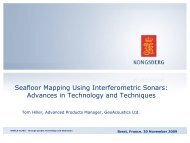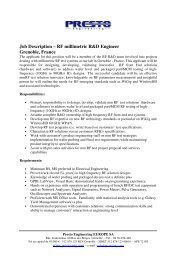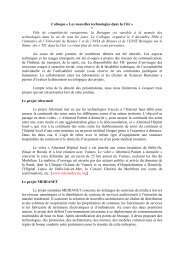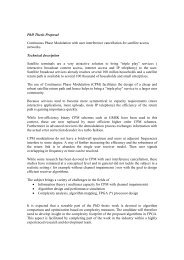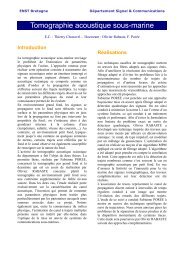Département Réseau, Sécurité et Multimédia Rapport d'Activités 2008
Département Réseau, Sécurité et Multimédia Rapport d'Activités 2008
Département Réseau, Sécurité et Multimédia Rapport d'Activités 2008
Create successful ePaper yourself
Turn your PDF publications into a flip-book with our unique Google optimized e-Paper software.
Compression techniques and IPv6 for mobilityResearch Staff : Jean-Marie Bonnin, Laurent Toutain – Ph.D. students: Priyanka RawatKeywords : h<strong>et</strong>erogeneous access n<strong>et</strong>works, header compression, ROHC, Context-awarenessPartners & Funding : project funded by SFRIntroductionThe recent development of Intern<strong>et</strong> makes IPprotocolsuite unavoidable in developing newservices. Almost all applications developed lastyears (Voice over IP, Peer-to-peer, InstantMessaging, Push-to-Talk,…) use theseprotocols even for real time and mobileservices. Unfortunately, neither IP nortransport protocols (UDP, TCP) have beenspecifically optimized for scarce resourcesusually available on wireless links.Furthermore, when application data areappropriately compressed the IP and transportprotocol headers remain very consuming.This is why using compression m<strong>et</strong>hodsbecomes more and more crucial to reduce thebandwidth consumption, and therefore th<strong>et</strong>ransmission delay.ObjectivesSeveral compression protocols have alreadybeen developed. Some of them are known tobe b<strong>et</strong>ter than others but they all have a majordisadvantage: None of these techniques ismulti-purpose. In fact, the efficiency of am<strong>et</strong>hod depends closely on the kind of flow tobe compressed and on the link characteristics(statics and/or dynamics).This justifies the wide vari<strong>et</strong>y of compressionm<strong>et</strong>hods in the way that each one is suitablefor a vari<strong>et</strong>y of data and is optimal undercertain link conditions. For example, headercompression m<strong>et</strong>hod are more adapted thanpayload compression m<strong>et</strong>hods when thepayload is already compressed at theapplication level (VoIP, video, …). Some of thecompression m<strong>et</strong>hods rely on a contextmaintained at each side of the link (whichcould be PPP or other link technologies such asSNDCP in GPRS or PDCP in UMTSarchitectures). These m<strong>et</strong>hods are then verysensitive to transmission errors: they areunable to rebuild original data since bothcontexts become desynchronized.To overcome the difficulty to choose onecompression m<strong>et</strong>hod for all flows during all theduration of a session, a suitable solution wouldbe to choose dynamically and automaticallythe most suitable compression m<strong>et</strong>hodregarding the flow type and linkcharacteristics. One of the aims of this projectis to design and evaluate an algorithm able toaccomplish this task [2].One of the most promising compressiontechniques is header compression such asROHC [1], especially when the user flowtransport information already compressed atthe application level. This is why the projectalso aims at evaluating the behavior of a ROHCimplementation over actual UMTS/GPRSaccess.RealizationWe integrated ROHC/TCP profile (RObustHeader Compression for TCP) proposed byIETF in our study. We implemented ROHC/TCPin order to evaluate its characteristics and itsperformances. It is an important compressionm<strong>et</strong>hod since it allows a significant overheadreduction for signaling traffics, which often useTCP as transport protocol, especially onIMS/UMTS n<strong>et</strong>works.In a study of ROHC behavior over IPv4UMTS/GPRS access we show that it is reallyefficient to send IPv6 traffic over a L2TP tunnelusing ROHC header compression; Almost asefficient as using directly IPv6 over GPRSaccess.A patent related to the automatic selection ofthe most adapted compression techniques ison the way with SFR.References[1] A. Couvreur, A. C. Minaburo Villar, L. LeNy, G. Rubino, B. Sericola, L. Toutain,"Performance analysis of a headercompression protocol: the ROHC unidirectionalmode", Telecommunication systems, Vol. 31,N° 1, p. 85-98, 2005.[2] R. Ben Rayana, J.-M. Bonnin, A. Belghith.“Sélection dynamique des protocoles decompression”, CFIP’2006 (ColloqueFrancophone sur l’Ingénierie des Protocoles),Tozeur, Tunisie, November 2006.Extract of Pracom’s Annual Report <strong>2008</strong> 5



